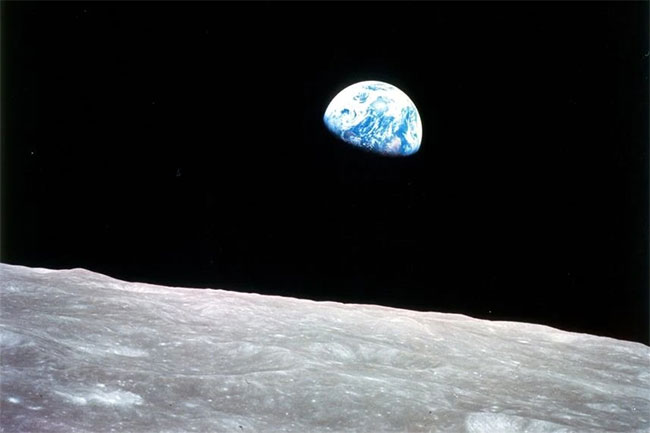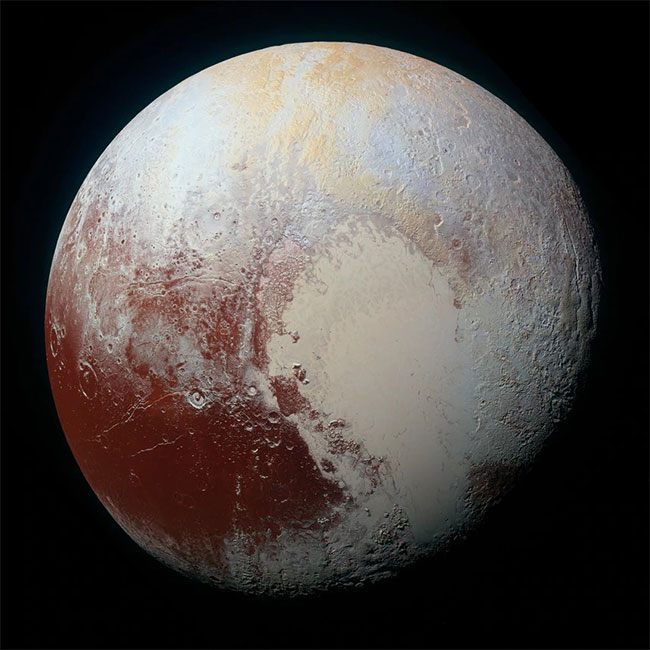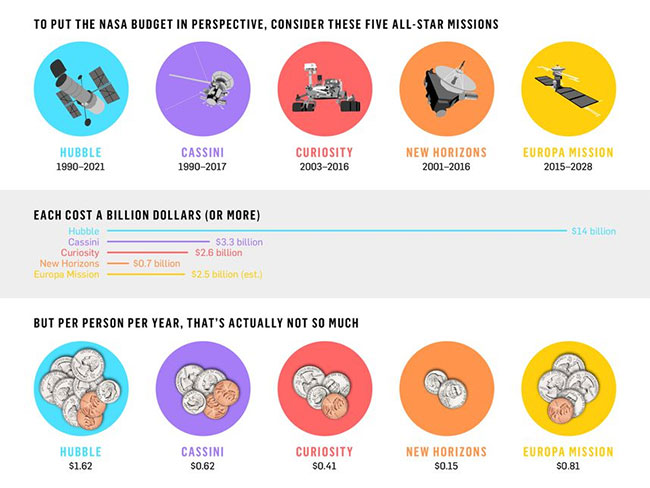How much does NASA spend on space exploration missions?
Since its inception in 1958, NASA has achieved many important feats in science. The US has successfully put humans on the Moon a total of 6 times, put a lab on the surface of Mars and flew across all the planets in the solar system, including the dwarf planet Ceres that recently is recognized as an asteroid.
Despite many achievements in the field of science and technology, many people still think that the US spending money for NASA is a waste. However, if the calculation is clear, actually we are getting more than we lose.

"Earthrise"
What does NASA bring to us?
NASA was founded because of the Cold War between the United States and the Soviet Union. After the Sputnik spacecraft was launched in 1957, President Eisenhower realized that the United States was lagging in space race. Therefore, on July 29, 1958, the National Aerospace Agency (NASA) was established. In signing the Space Act, President Eisenhower said the law was a pave the way for a new program: " There are many aspects of the universe and related technologies that will be of benefit to the people as the United States advances. conducting peaceful space exploration programs. Each person has the opportunity to share his or her understanding of the journey ahead . "
For the past 61 years, NASA has shown the world more about our race and our place in this universe. When the Apollo 8 ship sends back the famous photo "Earthrise" , this is the first time we have been able to see ourselves in this universe. On Valentine's Day 1990, on the journey to the outer solar system, the Voyager 1 spacecraft came back and took a picture of the entire Earth. The picture was taken at a distance of 6 billion km, in this picture we are so small, it seems just like other stars. Thanks to such moments, for decades, every child answered that when they grow up, they want to be an "astronaut" . These dreams were able to survive thanks to NASA.

Pluto, the image has been tinted to create better contrast.
Recently, the world once again gathered together, sharing a spirit of space exploration through the event of the New Horizons spacecraft flying over Pluto. Pluto was discovered in 1930 and is known as the farthest star in the solar system, humans have never known the shape of Pluto. On July 14, the whole world seemed to stop, all cheering for the new achievements of mankind, from social networks to every street. While people can't see the spacecraft, imagine the 9-year journey to get close, fly past Pluto and claim that it's more interesting than we think.
And the price is .
Inspired by science and the journey of discovery is humanity's greatest reward. But it's not free, especially in the field of space. So how much is the scientific knowledge of this universe worth?
Since the end of the Apollo program in 1972, NASA's operating budget has accounted for only 0.5% of the US budget. It accounted for less than 1% of the $ 3 trillion budget in 2014. Even so, it's still a pretty big sum, let's compare that to the time NASA started the Apollo program.
In 1961, President John F. Kennedy decided that NASA would have to send humans to the Moon before the end of this decade. At that time, the average American citizen contributed US $ 20 per year to NASA. President John F. Kennedy needs to raise this amount to 26 USD / year to be able to send people to the Moon. Converted to USD value in 2015, the Apollo program caused Americans to contribute over 200 USD per year for this space program. If NASA maintains such revenues in 2015, it will receive about $ 65 billion per year, while the actual budget for NASA in 2015 was $ 17.5 billion. In addition, in 2014, the average amount that Americans paid to NASA was $ 54 per year.
This money is allocated to many different projects. So even though the Curiosity car costs up to $ 2.6 billion, every citizen only has to pay about $ 0.41 per year to build and bring this car to Mars.

Actual cost of NASA missions.
Since 1972, the budget for NASA has not increased, but it has been cut by about 75% compared to the previous one and remains the same level so far. Although the budget of NASA at the time of Apollo is unclear, what could happen if NASA had greater financial capacity?
NASA can make money from long-term projects. In addition, conducting a scientific mission requires 60,000 employees, including private companies. But NASA cannot do all that work. The budget cuts have affected the development of the Commercial Crew program, which aims to create opportunities for astronauts to fly into space from the United States. Meanwhile, the United States was forced to buy a ticket to go to space on Russia's Soyuz.

In recent decades, the budget for NASA has not changed much.
What is ahead?
Despite struggling with the budget issue, NASA continues to conduct scientific research.
NASA's next journey to explore the universe is a flight towards Europa (a moon of Jupiter). This mission to the moon full of ice and snow this time makes the biologist about extraterrestrial life very excited. Because Europa has more water in the ocean than all the water on Earth, it is therefore capable of sustaining life.
There will be no other "Apollo moments" in space exploration programs
Scientists at NASA are working to get humans on Mars by 2030.
Many people acknowledge that there will be no other "Apollo moments" in space exploration programs. NASA will no longer receive the huge amount of funds it once had when President John F. Kennedy set a goal to set foot on the Moon. There will be no more Cold War, but there will always be a question: Is there anything else besides space?
Scientists have plowed the surface of most of the solar system's planets, and there are still many questions and many questions to be answered. The amount paid for knowledge is very small. Connecting the global humanity through a spacecraft launch, taking the device onto another planet, a photograph or a new space walk is invaluable. Do not stop. Keep moving forward and "challenge the mighty" as NASA once stated.
- Listed the great space exploration missions in history
- This is a 6.5-ton car that NASA will use to travel on Mars
- The world has some space agencies, do you know?
- With $ 19.5 billion of pumping, many of NASA's missions soon became a reality
- NASA recruited astronauts for Mars exploration campaign
- Disaster in space
- NASA will spend $ 1.6 billion to develop a space taxi
- NASA revealed the 'Hedgehog' robot to explore the universe
- NASA is embarrassed
- NASA has just opened two new missions to learn more about the Sun.
- Russia - America started building new houses on the universe
- China speeds up space
 Van Allen's belt and evidence that the Apollo 11 mission to the Moon was myth
Van Allen's belt and evidence that the Apollo 11 mission to the Moon was myth The levels of civilization in the universe (Kardashev scale)
The levels of civilization in the universe (Kardashev scale) Today Mars, the sun and the Earth are aligned
Today Mars, the sun and the Earth are aligned The Amazon owner announced a secret plan to build a space base for thousands of people
The Amazon owner announced a secret plan to build a space base for thousands of people